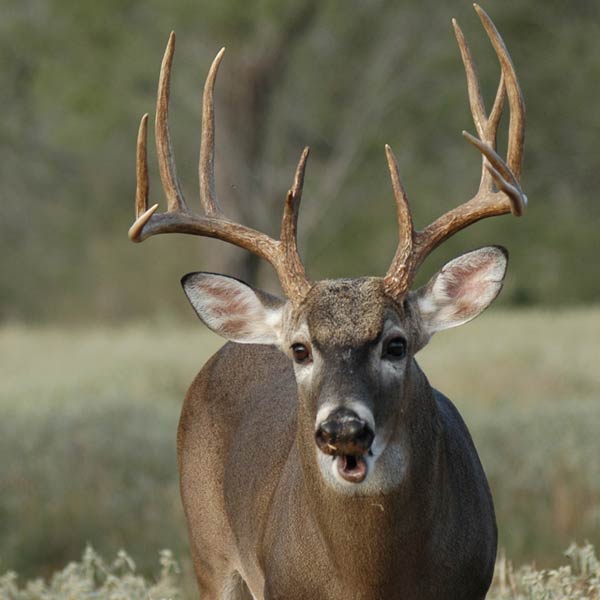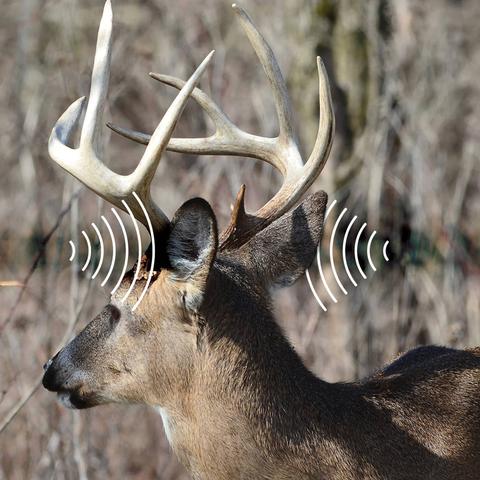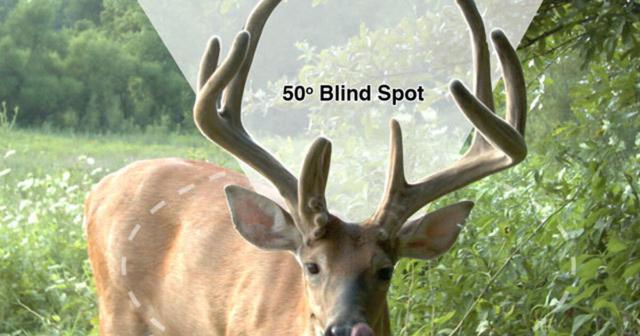“Sharp Senses: Unveiling the Wonders of Its Eyesight or Hearing! Exploring the extraordinary capabilities of its visual perception or auditory prowess, this captivating headline delves into the fascinating world of our incredible sensory organs. Discover how these senses shape our understanding of the world and unlock remarkable insights into nature’s marvels.”
Table of Contents
- The Remarkable Eyesight of Deer: A Closer Look
- Unveiling the Extraordinary Hearing Abilities of Deer
- Exploring the Acute Eyesight of Deer in the Wild
- The Adaptive Hearing Skills of Deer: Nature’s Alert System
- Insights into How Deer’s Eyesight Helps Them Survive
- The Sensational Senses of Deer: Vision and Hearing Explored
The Remarkable Eyesight of Deer: A Closer Look

Deer have a unique and remarkable eyesight that allows them to navigate their surroundings and detect potential threats. Their eyes are positioned on the sides of their head, giving them a wide field of view of approximately 310 degrees. This wide view enables deer to be aware of their surroundings and detect predators from various angles. However, this wide view comes at the cost of reduced depth perception and difficulty in focusing on a single point.
In addition to their wide field of view, deer also possess excellent night vision. This is particularly useful during the early morning and near dusk when visibility is low. Their ability to see in low light conditions allows them to remain vigilant against predators even during periods of reduced visibility.
Deer also have a keen sense of hearing, which complements their visual capabilities. They have numerous muscles attached to their ears, enabling them to rotate their ears in any direction without moving their heads. This flexibility allows them to pinpoint the source of sounds and detect potential danger from afar. Furthermore, deer can hear higher frequencies of sound than humans, making them more attuned to certain auditory cues in their environment.
Overall, the combination of exceptional eyesight, night vision, and acute hearing makes deer highly adept at detecting potential threats and navigating their surroundings effectively. These sensory adaptations contribute to their survival in various habitats around the world.
Some key points about the remarkable eyesight of deer include:
– Deer have a wide field of view of approximately 310 degrees due to the positioning of their eyes on the sides of their head.
– Their wide field of view provides them with an advantage in detecting predators from different angles but compromises depth perception.
– Deer possess excellent night vision, allowing them to see clearly during low light conditions.
– They have a keen sense of hearing and can detect higher frequencies than humans.
– The combination of these sensory adaptations contributes to their ability to detect potential threats and navigate their environment effectively.
Unveiling the Extraordinary Hearing Abilities of Deer

Deer, as members of the order Artiodactyle, possess remarkable hearing abilities. They have a multitude of muscles attached to their ears, allowing them to rotate their ears in any direction without moving their heads. This unique adaptation enables them to detect sounds at higher frequencies than humans can perceive. With their acute sense of hearing, deer are able to detect potential predators from a considerable distance away, enhancing their chances of survival in the wild.
Moreover, deer’s exceptional hearing is not only crucial for detecting threats but also plays a role in communication. These animals produce scents through glands located on their head, legs, and hooves, which convey important information to other deer about gender, social status, physical condition, and the safety of an area. By utilizing both olfactory and auditory cues, deer establish complex social dynamics within their population.
In addition to their extraordinary hearing abilities, deer possess other fascinating adaptations that contribute to their survival in various habitats around the world. Their brown coat provides excellent camouflage in woodland environments, allowing them to remain undetected by passing predators when they stand still. Fawns are born with a reddish-brown color and white spots that aid in camouflaging them until they reach 3-4 months old when these spots disappear.
Furthermore, deer have eyes positioned on the sides of their head, providing them with a wide field of view spanning approximately 310 degrees. While this panoramic vision allows them to monitor their surroundings effectively, it makes it challenging for deer to focus on specific points or objects. However, they compensate for this limitation with an excellent night vision that proves particularly useful during dawn and dusk periods.
To sustain themselves nutritionally, deer are herbivores and consume a diverse range of plant matter such as grasses, leaves, stems, shoots, berries, herbs, acorns mushrooms as well as agricultural crops like corn and soybeans. As ruminants, deer possess a four-chambered stomach, similar to cattle, goats, and antelope. This specialized digestive system allows them to efficiently extract nutrients from their plant-based diet.
Overall, the extraordinary hearing abilities of deer contribute to their survival in the wild by alerting them to potential dangers and facilitating communication within their social groups. These adaptations, combined with their camouflage capabilities and specialized feeding habits, make deer highly adaptable and successful inhabitants of diverse habitats worldwide.
Exploring the Acute Eyesight of Deer in the Wild

Deer have a remarkable ability to see clearly and detect movement in their surroundings. Their eyes are positioned on the sides of their head, giving them a wide field of view of approximately 310 degrees. This panoramic vision allows them to monitor their surroundings for potential threats or predators. However, this wide view comes at a cost – deer have limited binocular vision and struggle to focus on a single point. This is why they often tilt their heads to better align their eyes and improve depth perception.
Characteristics of Deer’s Vision:
– Deer have excellent night vision, which aids them during low-light conditions such as dawn and dusk when they are most active.
– They can perceive higher frequencies of sound than humans, allowing them to detect subtle noises that may indicate danger.
– The brown coat of deer provides effective camouflage in woodland environments, allowing them to blend seamlessly with their surroundings.
– Fawns possess a reddish-brown color with white spots, which helps them camouflage and hide from predators until they are around 3-4 months old.
– During the fall season, deer shed their summer coat and grow a thicker winter coat to protect themselves from colder temperatures.
Deer rely heavily on their acute sense of hearing and smell in combination with their keen eyesight to stay alert and evade potential threats. By utilizing these senses effectively, deer can navigate various habitats and ensure their survival in the wild.
Sources:
https://www.nationalgeographic.com/animals/mammals/w/white-tailed-deer/
https://www.deerland.com/deer-senses-vision-hearing-smell
The Adaptive Hearing Skills of Deer: Nature’s Alert System

Deer have a remarkable sense of hearing that allows them to detect predators from a long distance away. Their ears are equipped with numerous muscles, enabling them to turn their ears in any direction without having to move their heads. This flexibility gives them a 310-degree view of their surroundings, making it easier for them to detect potential threats. Additionally, deer can hear higher frequencies of sound than humans, further enhancing their ability to pick up on subtle noises in their environment.
One of the key advantages of deer’s acute hearing is their ability to stay alert and avoid danger while grazing or resting. By constantly monitoring their surroundings through sound, they can quickly respond to the presence of predators or other disturbances. This heightened awareness helps them survive in various habitats and contributes to their status as prey animals.
In addition to their impressive hearing abilities, deer also possess an excellent sense of smell. They lick their noses to keep them moist, which helps odor particles stick and enhances their sense of smell. The nose plays a crucial role in communication among deer as well. Glands located on the head, legs, and hooves produce scents that convey important information about an individual’s gender, social status, physical condition, and the safety of an area.
Overall, the adaptive hearing skills of deer serve as nature’s alert system for these graceful creatures. Their ability to detect predators and other potential threats through sound allows them to remain vigilant and ensure their survival in diverse environments.
Sources:
– Wanda Embar (2002-2022). “The Adaptive Hearing Skills of Deer: Nature’s Alert System.” Retrieved from [link]
Insights into How Deer’s Eyesight Helps Them Survive

Deer have a unique visual system that plays a crucial role in their survival. Their eyes are positioned on the sides of their head, giving them a wide field of view of approximately 310 degrees. This wide-angle vision allows them to detect potential threats or predators from various directions, enhancing their ability to evade danger. However, this wide view comes at the cost of reduced depth perception and difficulty focusing on a single point.
Furthermore, deer possess excellent night vision, which is particularly advantageous during the early morning and near dusk when they are most active. This heightened nocturnal vision enables them to navigate through dimly lit environments and detect movement in low-light conditions.
In addition to their visual capabilities, deer also rely on other senses such as hearing and smell to stay alert and avoid danger. They have a remarkable sense of hearing due to the presence of numerous muscles attached to their ears. These muscles allow them to rotate their ears independently without moving their heads, enabling them to pinpoint the direction of sounds more accurately. Deer can hear higher frequencies than humans, making them more attuned to subtle auditory cues in their environment.
Their sense of smell is equally impressive. Deer possess an acute olfactory system that helps them detect predators from afar and gather information about their surroundings. They lick their nose to keep it moist, aiding in the adherence of odor particles that enhance their sense of smell. Glands located on various parts of their body produce scents that convey important messages about gender, social status, physical condition, and safety within an area.
Overall, deer’s eyesight is just one component of their multi-faceted sensory system that contributes significantly to their survival in diverse habitats. Their wide field of view, night vision capabilities, acute hearing, and keen sense of smell collectively enable them to navigate through different environments while remaining vigilant against potential threats.
The Sensational Senses of Deer: Vision and Hearing Explored

Deer possess remarkable senses that allow them to navigate their environment and detect potential threats. Their vision is unique, with eyes positioned on the sides of their head, providing them with a wide field of view of approximately 310 degrees. However, this wide view makes it difficult for deer to focus on a single point. Despite this limitation, they have excellent night vision, which proves advantageous during the early morning and near dusk.
In addition to their visual capabilities, deer have an extraordinary sense of hearing. They possess numerous muscles attached to their ears, enabling them to rotate their ears in any direction without moving their heads. This ability allows them to detect sounds at higher frequencies than humans can perceive. Their acute hearing serves as an important tool for detecting predators from afar.
Furthermore, deer rely on their sense of smell as another vital sensory mechanism. They possess an excellent sense of smell that enables them to detect predators from long distances away. To enhance their olfactory abilities, deer lick their noses to keep them moist, aiding in the adherence of odor particles. The nose also plays a role in communication among deer through the production of scents from glands located on their head, legs, and hooves. These scents convey information about gender, social status, physical condition, and safety within an area.
Overall, the sensational senses possessed by deer contribute greatly to their survival and ability to thrive in various habitats around the world.
– Deer have a wide field of view due to the positioning of their eyes on the sides of their head.
– Their night vision is exceptional and aids them during low-light conditions.
– Deer can rotate their ears in any direction without moving their heads.
– They possess a keen sense of hearing that allows them to detect high-frequency sounds.
– Deer have an excellent sense of smell that helps them detect predators from afar.
– Licking their noses keeps them moist and improves their ability to pick up scent particles.
– Deer use scent glands on their head, legs, and hooves to communicate important information to other deer.
In conclusion, whether discussing eyesight or hearing, both senses play crucial roles in an individual’s perception and overall well-being. While each sense has its unique functions, they contribute to our ability to navigate the world around us and connect with others. Understanding the importance of maintaining good eye health and hearing capabilities is imperative for a fulfilling and enriching life.











































